Wednesday, Sept. 28 – Aswan
Wednesday, September 28, 2016
A review of a Journey through Egypt along the Nile River.
Up early this morning at 6 a.m. ready for another day of feeling and connecting with Sacred Sites and the People of Egypt.
The Low and High Aswan Dam
https://www.youtube.com/watch?v=jYEk6WdhnJ8
The above is a tourist impression.
https://www.youtube.com/watch?v=jjfpfFzQYjI
The above is more a documentary
Aswan Low Dam, 1898–1902
The British began construction of the first dam across the Nile in 1898. Construction lasted until 1902, and the dam was opened on 10 December 1902. The project was designed by Sir William Willcocks and involved several eminent engineers, including Sir Benjamin Baker and Sir John Aird, whose firm, John Aird & Co., was the main contractor.[
Aswan High Dam prelude, 1954–1959
In 1912 the Greek-Egyptian engineer Adrian Daninos began to develop the plan of the new Aswan Dam. Although the Low Dam was almost over-topped in 1946, the Egyptian government of King Farouk showed no interest in Daninos’s plans. Instead the Nile Valley Plan by British hydrologist Harold Edwin Hurst to store water in Sudan and Ethiopia, where evaporation is much lower, was favored. The Egyptian position changed completely with the overthrow of the monarchy, led by the Free Officers Movement including Gamal Abdel Nasser. The Free Officers were convinced that the Nile Waters had to be stored in Egypt for political reasons, and within two months the plan of Daninos was accepted. Initially, both the US and the Soviet Union were interested in the development of the dam, but this occurred in the midst of the Cold War, as well as growing intra-Arab rivalries.
In 1955 Nasser was trying to portray himself as the leader of Arab nationalism, in opposition to the traditional monarchies, especially Hashemite Iraq following its signing of the 1955 Baghdad Pact. At that time the US feared that communism would spread to the Middle East and saw Nasser as a natural leader of an anti-communist pro-capitalist Arab League. America and Britain offered to help finance construction of the high dam, with a loan of US$270 million, in return for Nasser’s leadership in resolving the Arab-Israeli conflict. While opposed both to communism, capitalism, and imperialism, Nasser presented himself as a tactical neutralist, and sought to work with both the United States and the Soviet Union for Egyptian and Arab benefit. After a particularly criticized raid by Israel against Egyptian forces in Gaza in 1955, Nasser realized that he could not legitimately portray himself as the leader of pan-Arab nationalism if he could not defend his country militarily against Israel. In addition to his development plans, he looked to quickly modernize his military, and turned first to the US.
Egyptian President Nasser and Russian leader Nikita Khrushchev at the ceremony to divert the Nile during the construction of the Aswan High Dam on May 14, 1964. At this occasion Khrushchev called it “the eighth wonder of the world“.
US Secretary of State John Foster Dulles and American President Dwight Eisenhower told Nasser that the US would supply him with weapons only if they were used for defensive purposes and accompanied by US military personnel for supervision and training. Nasser did not accept these conditions and then looked to the Soviet Union for support. Although Dulles believed that Nasser was only bluffing and that the Soviet Union would not aid Nasser, he was wrong—the Soviet Union promised Nasser a quantity of arms in exchange for a deferred payment of Egyptian grain and cotton. On 27 September 1955, Nasser announced an arms deal, with Czechoslovakia acting as a middleman for the Soviet support. Instead of attacking Nasser for turning to the Soviets, Dulles sought to improve relations with him. This explains the later offer of December 1955, in which the US and Britain pledged $56 and $14 million respectively towards the construction of the dam.
Gamal Abdel Nasser observing the construction of the dam, 1963
Though the Czech arms deal increased US willingness to invest in Aswan, the British cited the deal as a reason for betraying their promise of funds. What angered Dulles much more was Nasser’s recognition of China, which was in direct conflict with Dulles’s policy of containment.[10] There are several other reasons why the US decided to withdraw the offer of funding. Dulles believed that the Soviet Union would not fulfill its commitment to help the Egyptians. He was also irritated by Nasser’s neutrality and attempts to play both sides of the Cold War. At the time, other western allies in the Middle East, including Turkey and Iraq, were irritated and jealous that Egypt, a persistently neutral country, was being offered so much aid.[11]
In June 1956, the Soviets offered Nasser $1.12 billion at 2% interest for the construction of the dam. On 19 July, the US State Department announced that American financial assistance for the High Dam was “not feasible in present circumstances.”
On 26 July 1956, with wide Egyptian acclaim, Nasser announced the nationalization of the Suez Canal as well as fair compensation for the former owners. Nasser planned on the revenues generated by the canal helping to fund construction of the High Dam. When the Suez War broke out, the United Kingdom, France, and Israel seized the canal and the Sinai, but pressure from the US and the Soviet Union at the United Nations and elsewhere forced them to withdraw.
In 1958, the Soviet Union provided funding for the dam project.
The Aswan Dam is an embankment dam built across the Nile at Aswan, Egypt between 1898 and 1902. Since the 1960s, the name commonly refers to the Aswan High Dam. Construction of the High Dam became a key objective of the Egyptian Government following the Egyptian Revolution of 1952, as the ability to control floods, provide water for irrigation, and generate hydroelectricity were seen as pivotal to Egypt’s industrialization. The High Dam was constructed between 1960 and 1970, and has had a significant effect on the economy and culture of Egypt.
Before the dams were built, the Nile flooded every year during late summer, when water flowed down the valley from its East African drainage basin. These floods brought high water and natural nutrients and minerals that annually enriched the fertile soil along the floodplain and delta; this had made the Nile valley ideal for farming since ancient times. Because floods vary, in high-water years the whole crop might be wiped out, while in low-water years widespread drought and famine occasionally occurred. As Egypt’s population grew and conditions changed, both a desire and ability developed to control the floods, and thus both protect and support farmland and the economically important cotton crop. With the reservoir storage provided by the Aswan dams, the floods could be lessened and the water stored for later release.
Personal note: To stand on top of the giant High Dam a strong wind blows. As I looked over I had a feeling that I was in the Air looking down on the river Nile.
Philae Temple
We went by motorboat to the Island where Philae Temple can be visited.
A reconstruction of Philae Temple.
Temple of Isis at Philae
Philae Temple

Philae in Greek or Pilak in ancient Egyptian, meaning ‘the end,’ defined the southernmost limit of Egypt. It was begun by Ptolemy II and completed by the Roman Emperors.
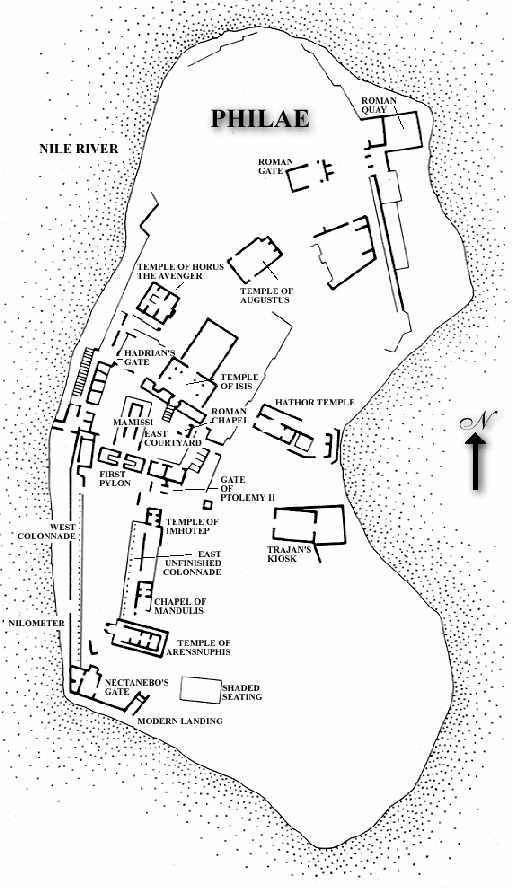
The Temple was dedicated to the goddess Isis, the wife of Osiris and mother of Horus. These three characters dominate ancient Egyptian culture and their story possesses all the drama of a Shakespearian tragedy. The god Osiris is murdered and dismembered by his brother Seth. Isis searches for the fragments, collects them together and with her magic powers brings Osiris back to life. They then conceive the god Horus. Osiris becomes god of the underworld and judge of the dead – who must answer to him for their deeds on Earth. Meanwhile Isis gives birth to Horus and protects the young god. Later when Horus is grown he avenges his father by defeating Seth in combat.
Isis is a very important figure in the ancient world. She is associated with funeral rites but as the enchantress who resurrected Osiris and gave birth to Horus she is also the giver of life, a healer and protector of kings. She was known as ‘Mother of God’ and was represented with a throne on her head. During the Roman period her cult spread throughout Greece and the Roman Empire. There was even a temple dedicated to her in London.
The temple at Philae was nearly lost under water when the high Aswan dam was built in the 1960s. Fortunately the temple was rescued by a joint operation between the Egyptian government and UNESCO. In an engineering feat to rival the ancients the whole island was surrounded with a dam and the inside pumped dry. Then every stone block of the temple complex was labelled and removed later to be assembled, like a giant jigsaw puzzle, on the higher ground of Agilka island. The whole project took ten years and has saved one of Egypt’s most beautiful temples from certain destruction.

Philae temple, dedicated to the goddess Isis, is in a beautiful setting which has been landscaped to match its original site. It’s various shrines and sanctuaries, which include The Vestibule of Nectanebos I which is used as the entrance to the island, the Temple of the Emperor Hadrian, a Temple of Hathor, Trajan’s Kiosk (Pharaohs Bed), a birth house and two pylons celebrate all the deities involved in the Isis and Osiris myth. The Victorian world fell in love with the romance of the Temple. But at night you can also visit the Sound and Light Show, a magical experience as floodlit buildings are silhouetted against the volcanic rocks and water surrounding them. So today, Philae is more fun then every before.
Although antiquities on the island date between the 26th Dynasty and the Roman Period, most of the work is from that of the Roman. This was a time of immense popularity of the Goddess Isis, and this was her island, where pilgrims would come from all over the Mediterranean. Construction on the island took place over an 800-year span, and it was one of the last strongholds of Ancient Egyptian Religion which continued to flourish here into the 6th Century. When the Temples where finally closed by Justinian in A.D 550, it ended 4,000 years of worship of the pagan gods.
Vestibule of Nectanebos I at Philae
This is the entrance for the Island of Philae. The Vestibule of Nectanebos I is a logical beginning for an exploration of Philae. It is also where boats usually land on the island. This temple dating to the 30th dynasty was dedicated to Nectanebos “Mother” Isis. There are few other antiquities on the island that are not Ptolemaic or Roman. There was once a double stairway leading to the vestibule, but they were washed away by the Nile, along with the temple it once led to. It once had 14 columns, but today there remain only six. The vestibule itself was rebuilt by Ptolemy II Philadelphos. Some architectural styling of this monument date to the 3rd Dynasty. There are two rows of colonnades which form a walkway to the first pylon of the Temple of Isis.
The Temple of Emperor Hadrian (Philae Island)
Just to the west of the Temple of Isis on Philae is the Gateway of the Emperor Hadrian, which was once set into a wall that encircled the island. There are various scenes involving Osiris, as well as other gods and the Emperor Hadrian. In the vestibule that proceeds the gate there is an image of the Nile god entwined by a serpent and pouring water from two jars, symbolizing the birth of the Nile River. To the north of the gate are the remains of the Temple of Harendotes.
The Temple of Hathor at Philae
There is also a Temple of Hathor at Philae. This was the temple dedicated to Hathor by Ptolemies IV Philometor and VIII (Euergetes II), who was a goddess similar to Aphrodite despite her association with cows. The columns are noted for their decorations of Bes and musical scenes thought to placate the gods.
Trajan’s Kiosk (Pharaoh’s Bed)
The Trajan’s Kiosk was certainly the icon of Philae Island, the structure most associated by people with the island. It is a beautiful structure of 14 massive columns with carved floral capitals, but simple in its design. Inside are reliefs showing Trajan as a pharaoh making offerings to Osiris, Isis and Horus. The Emperor Trajan lived around 100 AD.
Birth House
Referring to ancient Egyptian religion, the birth house was an attachment to a temple where the rites associated with the god-kings were performed. The interior walls usually record scenes from the divine marriage and the king’s birth.
View of what’s left of the original island now submerged. The Temple of Isis or the other temples, is no longer at the island of Philea, which was inundated by the Aswan Dams, partly from 1902, completely from the 1960s. But with the help of UNESCO all the monuments were transported to the nearby island of Aglika, 500 away. Most of the original structures and organisations have been reconstructed. The weird attraction of Philae from the 1930s, of swimming around the temple ruins, looking down, through the water, at the reliefs of the walls, is now gone. The move lasted from 1972 to 1980.
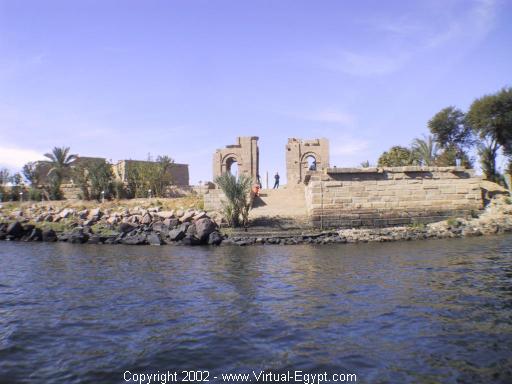
Quick view of Hathors Temple while arriving at the island.

A view of the majestic Trajan’s Kiosk.

Close up of a column which is richly decorated with offerings.
The gateway of king Nectanebo II (350 – 341 BC). This is the entrance to the temple of Isis. Isis embodied the role of a nourishing goddess and wife of Osiris, she was the object of a cult long after the introduction of Christianity. It was believed that Philae was one of those sacred places where a part of the mutilated body of Osiris was buried. The Island was the venue for one of the annual Osiris passion plays which brought vast crowds of worshipers. 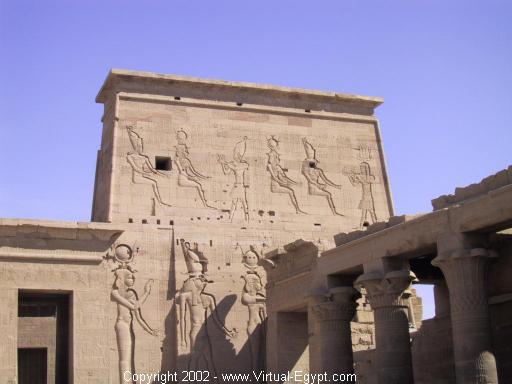
Beautiful reliefs which have also been recently restored.

Entrance to the Temple

Elaborate ceilings decorated with Eagles and Vultures.

Priestly presentation to the mighty Horus.

Ten huge, beautifully painted pillars adorn the room. They symbolize the first plants, trees and flowers of the earth which began to grow on the Primeval Mound (symbolized by the temple floor). In the ceiling (the sky), are images of the Day Boat and the Night Boat, and of the vultures of Upper and Lower Egypt.
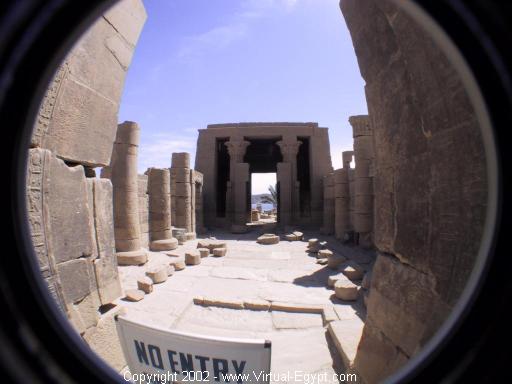
Temple of Hathor. The small temple of Hathor, just east of the great temple of Isis and facing towards the west, was built by Ptolemy VI and extended by Ptolemy VIII and the Roman emperors Augustus and Tiberius. It consists of a so called kiosk with fourteen Hathor-headed columns, a pronaos and a cult terrace at the back of the temple facing the Nile. The beautiful reliefs on the temple walls depict musicians playing for the entertainment of the gods, all in accordance with the patron deity Hathor, of singing, music and dance.

A last look down the West Colonnade in front of the First Pylon.
Personal Note: I was amazed at the perfection that is shown here. The energy feels intriguing yet also subtle.
Philae Perfume Palace

Perfume in Ancient Egypt
The Ancient Egyptians loved beautiful fragrances. They associated them with the gods and recognized their positive effect on health and well-being. Perfumes were generally applied as oil-based salves, and there are numerous recipes and depictions of the preparation of perfume in temples all over Egypt.
The god of perfume, Nefertum, was also a god of healing who was said to have eased the suffering of the aging sun god Re with a bouquet of sacred lotus. He could be described as the world’s first aromatherapist!
Egypt was the world leader in the creation of perfume and was closely associated with the international perfume trade. When Julius Caesar took control of Egypt, he demonstrated this fact to the Roman people by throwing bottles of precious perfume to the crowd during his triumphant return to Rome.
The most highly prized perfumes of the ancient world came from Egypt. Of these, arguably the most popular were Susinum (a perfume based on lily, myrrh, cinnamon), Cyprinum (based upon henna, cardamom, cinnamon, myrrh and southernwood) and Mendesian (myrrh and cassia with assorted gums and resins). Mendesian was named after the ancient city of Mendes, and although the perfume was produced in other locations later, the best variety was still thought to be that from Mendes.
They also loved Stakte, a perfume with a fairly strong aroma of myrrh, Rhondinium (based on the highly popular scent of rose) and a scent simply known as “the Egyptian” which seems to have been based on cinnamon and myrrh with sweet wine. Perfumes were generally stored in beautiful alabaster bottles, but there is also some evidence that blue glass bottles may also have been used.

Reference: http://www.ancientegyptonline.co.uk/perfume.html
Personal note: Being an aroma therapist myself this was a wonderland to be in. The whole group to smelled Papyrus and Lotus and sniffed up the mint oil. We have brought some one flower essence of Lotus and Mimosa plus Aromatherapy External Frankincense, Lavender and Royal Amber with us. It was partially a gift for daughter Jessica and her friend Antal who were thrilled by Royal Amber, Lavender, Lotus and Mimosa when given to them along with a special Egyptian aroma lamp as well. I will certainly share with others.
The botanical garden of Aswan(Kitchener’s Island)

Among the famous visits in Aswan is to see the botanical gardens of Aswan , you can sail in a local felucca boat or take a motor boat to the eastern bank of the Nile to reach this island. where this botanical island is located opposite the city of Aswan and the elephantine island.
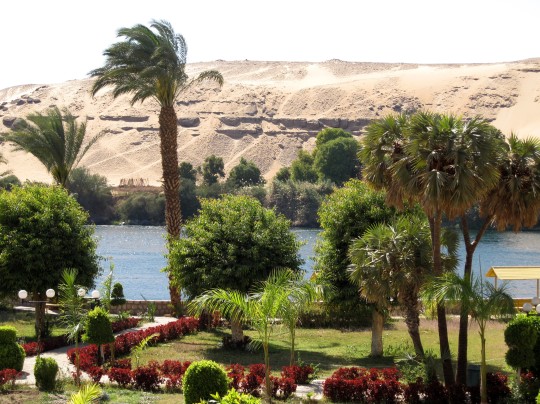
History of the Island:
Other names of the island is Kitchener island because in 1899 lord Kitchener during his military campaigns in the Sudan made the island his head-quarter for his army, it was then known as the lords house.
Soon after the lord left the island it was given back to the ministry of irrigation and was then known as the Kings island.
Ever since 1928 and the ministry of irrigation has transferred the island into natural part full of trees from the 5 continents.

How to visit the Island:
The island has 3 entrances. The main entrance is located on the northern tip off the island, the entrance fees is 10 EGP. The best way to see the island in full and save walking is to get of at the main entrance and walk the full length of the island till you reach the southern tip of the island and get your felucca from there. You may need to ask your felucca man to wait for you at the other end. The Aswan botanical island is divided into 27 squares with veridical and horizontal paths cutting each other making it like a chess board.

There is huge variety of plantation and trees at the island some of which is naturally found on the island before it was converted into botanical island and others have been brought in. There are number of very rare palm trees in the island such as the Royal palm tree, the Sabal Palm tree and the phonic Palm tree.
Personal Note: Enjoyed walking through this garden. The trees spread their energies of clear air, peacefulness and tranquility. There were various families here enjoying a good time together. Whilst walking alone a man with a baby in his arms beckoned me and via body language asked if he could take a photograph of me and the baby. The baby was of Nubian origin and me with my white grey hair and fair skin must have been something that has some deeper significance for the man. The baby was very willing to stay in my arms whilst the photographs were taken. There were also other children who jumped around me as well and later at a distance were laughing.
Boot through a Nature Area with many birds and some rocks in the form of an Elephant plus a visit to a Nubian Village
Nubian Village : Close to the Nature
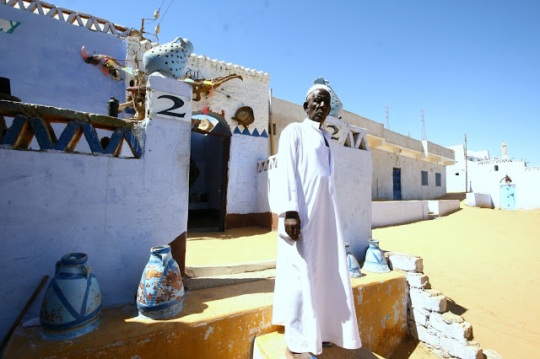 |
| Nubian Tribesman |
You have not seen a place if you have not experienced how locals/ethnic groups live.
To get a peek into the life of how ethnic Egyptians used to live, you need to visit a Nubian Village. You will be surprised to see a different lifestyle close to the nature.
So who are the Nubian People – As Wikipedia describes, the term Nubian describes an ethnic group that originated in modern-day Sudan and Egypt. Today, people of Nubian descent primarily live in Sudan, and inhabit the region between Wadi Halfa in the north and Al Dabbah in the south. The main Nubian groups from north to south are the Halfaweyen, Sikut, Mahas, and Dongola. They speak a variety of Nilo-Saharan languages in the Nubian language family. Nubian people have a long history dating back to dynastic Egypt, and Nubians even founded a dynasty that ruled upper and lower Egypt during the 8th century BCE.Ancient Nubians were famous for their skill and precision with the bow.
How to Reach Nubian Village
Take a Felucca (a boat which uses sails to propel) ride from Aswan. Hiring a boat alone will cost you huge amount of money, however you will find many boats which take the travellers on a sharing basis. You have to negotiate with the boatmen, they usually charge around $12-$25 (100-200 Egyptian pound) per person.
Note: You might get motor boats also, however If you are seeking exotic adventures then a Felucca would be your best choice in Aswan.
The tour will last for 3 hours from Pickup to Drop
 |
| Felucca Boat |
What to Expect
I read about Nubian people’s lifestyle and wanted to visit a traditional village. However I got so mesmerised by magnificent historical sites of Egypt that I almost forgot to visit the Nubian village. I suddenly remembered the village while having a Sheesha(hookah) at a Aswan eatery when few locals were discussing something about Nubia.
Now again the interest rekindled in me and the very next morning I left my hotel to visit the Nubian village.
After negotiations I finally took a Felucca to visit the village (my felucca charged $15 per person).
Oh what a sail it was !!! Soon we were on the Nile river. As I was enjoying the slow sailing, suddenly our boatmen took local musical instruments and started singing. Soon all the people in the boat were clapping and dancing to the tunes. We were almost sailing near the shores of Nile.
After sailing for almost 20mins the Felucca anchored at Small Island so that if anyone wants to swim in river Nile they can do so. Few people dared to swim – Dared because everyone has heard of stories about dreaded Nile Crocodiles. Good that the crocodiles were on a diet and the people came back to Felucca happily.
Another 15mins our Felucca anchored and we were told that we have reached the Nubian village. From the boat the village looked unattractive.
You will get two options to reach the village from the river bank: Camel Back or Walking. I chose the latter option as I wanted to see the village close. After 10 mins of walking I was in the mid of colourful decorated houses.
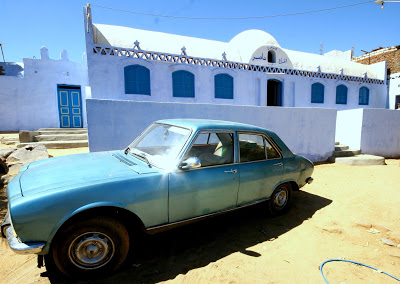 |
| Nubian Houses |
The houses were mostly white but they had intricate colourful designs on them. For a moment it looked like a fairy land however once you look at the houses you will be surprised to see that the doors of the houses are decorated with stuffed animals they had hunted. I was told that the more powerful a person was in the village the more were the stuffed animals on their doors.
 |
| Stuffed Animals |
 |
| Pet Crocodile |
Nubians live in houses painted with bright colours. Traditionally, the floor was made of sand and not all the rooms were roofed. Protection against rain is not a priority since Aswan is one of the driest places in the world.
Nubians are friendly and hospitable. They often invite you to their homes for a cup of tea or “Karkade”, a drink made of hibiscus flowers. Many would happily show you their handicrafts (Tip- don’t buy handicrafts they are exorbitantly priced)
When I heard the Nubians speak I found the language extremely soothing to the ears. The Nubians speak Nobiin or Mahas language.
As I entered one of the houses I found extremely beautiful interiors. I was surprised to see that the people had Nile crocodiles as pets and they would pick it up with their hands as if it was a small lizard. I was asked to touch and hold one of the baby crocodiles, I somehow managed to hold the baby crocodile for few seconds. They wouldn’t allow you to click the pictures of children as they believe it brings bad luck to their children.
Then I roamed on the streets of Nubian village where I was many women selling various handicrafts items.
 |
| Woman Selling Handicrafts |
Article written by: http://www.shoestringtravel.in/2016/06/nubian-village-close-to-nature.html
Personal Note: Enjoyed to meet, greet and feel how these villagers are so intertwined with each other. It was very relaxing and comfortable to be walking here.
We went by motorboat back to the cruise boot to have a late lunch and a relaxing afternoon and evening.
Gratitude for this wonderful morning.




You must be logged in to post a comment.